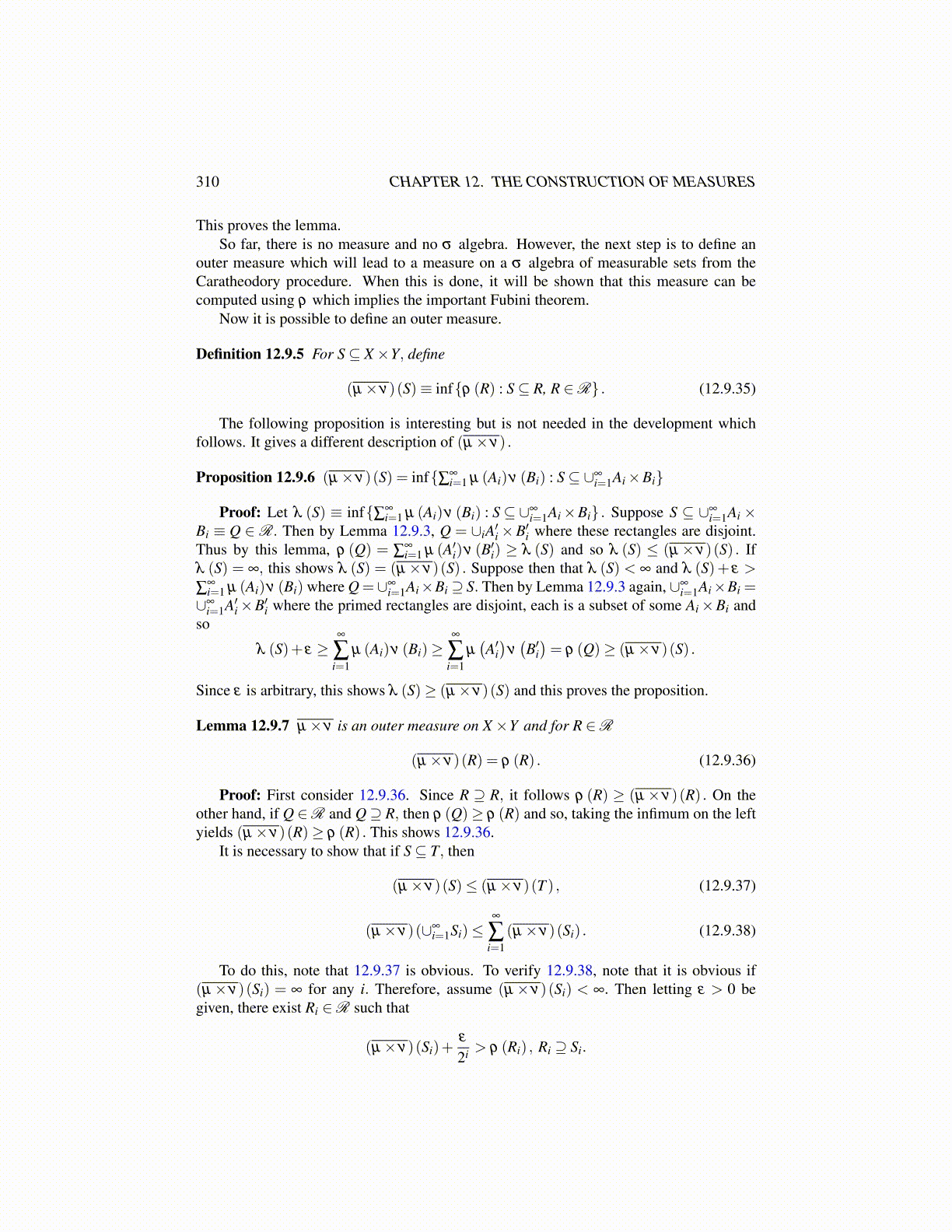
310 CHAPTER 12. THE CONSTRUCTION OF MEASURES
This proves the lemma.So far, there is no measure and no σ algebra. However, the next step is to define an
outer measure which will lead to a measure on a σ algebra of measurable sets from theCaratheodory procedure. When this is done, it will be shown that this measure can becomputed using ρ which implies the important Fubini theorem.
Now it is possible to define an outer measure.
Definition 12.9.5 For S⊆ X×Y, define
(µ×ν)(S)≡ inf{ρ (R) : S⊆ R, R ∈R} . (12.9.35)
The following proposition is interesting but is not needed in the development whichfollows. It gives a different description of (µ×ν) .
Proposition 12.9.6 (µ×ν)(S) = inf{∑∞i=1 µ (Ai)ν (Bi) : S⊆ ∪∞
i=1Ai×Bi}
Proof: Let λ (S) ≡ inf{∑∞i=1 µ (Ai)ν (Bi) : S⊆ ∪∞
i=1Ai×Bi} . Suppose S ⊆ ∪∞i=1Ai ×
Bi ≡ Q ∈ R. Then by Lemma 12.9.3, Q = ∪iA′i×B′i where these rectangles are disjoint.Thus by this lemma, ρ (Q) = ∑
∞i=1 µ (A′i)ν (B′i) ≥ λ (S) and so λ (S) ≤ (µ×ν)(S) . If
λ (S) = ∞, this shows λ (S) = (µ×ν)(S) . Suppose then that λ (S) < ∞ and λ (S)+ ε >
∑∞i=1 µ (Ai)ν (Bi) where Q =∪∞
i=1Ai×Bi ⊇ S. Then by Lemma 12.9.3 again, ∪∞i=1Ai×Bi =
∪∞i=1A′i×B′i where the primed rectangles are disjoint, each is a subset of some Ai×Bi and
so
λ (S)+ ε ≥∞
∑i=1
µ (Ai)ν (Bi)≥∞
∑i=1
µ(A′i)
ν(B′i)= ρ (Q)≥ (µ×ν)(S) .
Since ε is arbitrary, this shows λ (S)≥ (µ×ν)(S) and this proves the proposition.
Lemma 12.9.7 µ×ν is an outer measure on X×Y and for R ∈R
(µ×ν)(R) = ρ (R) . (12.9.36)
Proof: First consider 12.9.36. Since R ⊇ R, it follows ρ (R) ≥ (µ×ν)(R) . On theother hand, if Q ∈R and Q⊇ R, then ρ (Q)≥ ρ (R) and so, taking the infimum on the leftyields (µ×ν)(R)≥ ρ (R) . This shows 12.9.36.
It is necessary to show that if S⊆ T, then
(µ×ν)(S)≤ (µ×ν)(T ) , (12.9.37)
(µ×ν)(∪∞i=1Si)≤
∞
∑i=1
(µ×ν)(Si) . (12.9.38)
To do this, note that 12.9.37 is obvious. To verify 12.9.38, note that it is obvious if(µ×ν)(Si) = ∞ for any i. Therefore, assume (µ×ν)(Si) < ∞. Then letting ε > 0 begiven, there exist Ri ∈R such that
(µ×ν)(Si)+ε
2i > ρ (Ri) , Ri ⊇ Si.